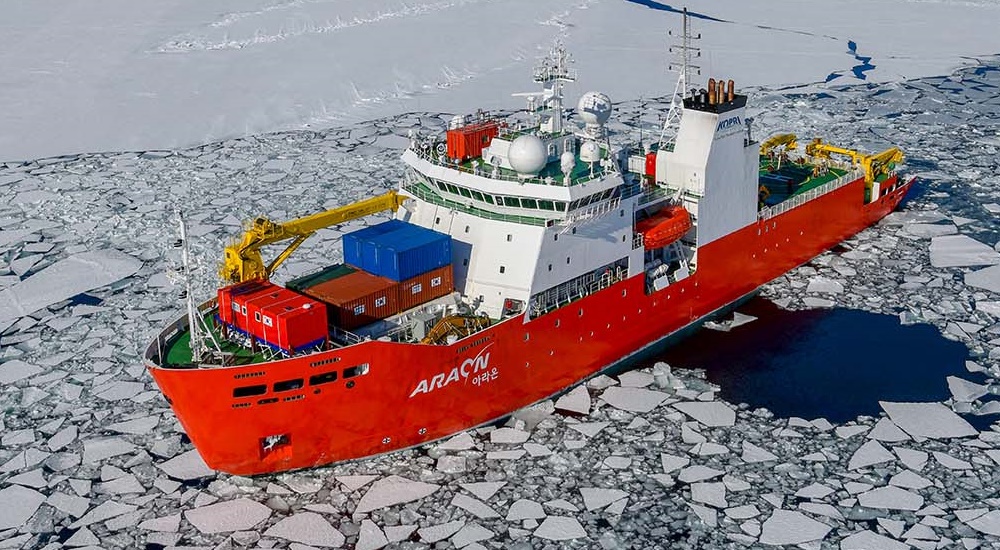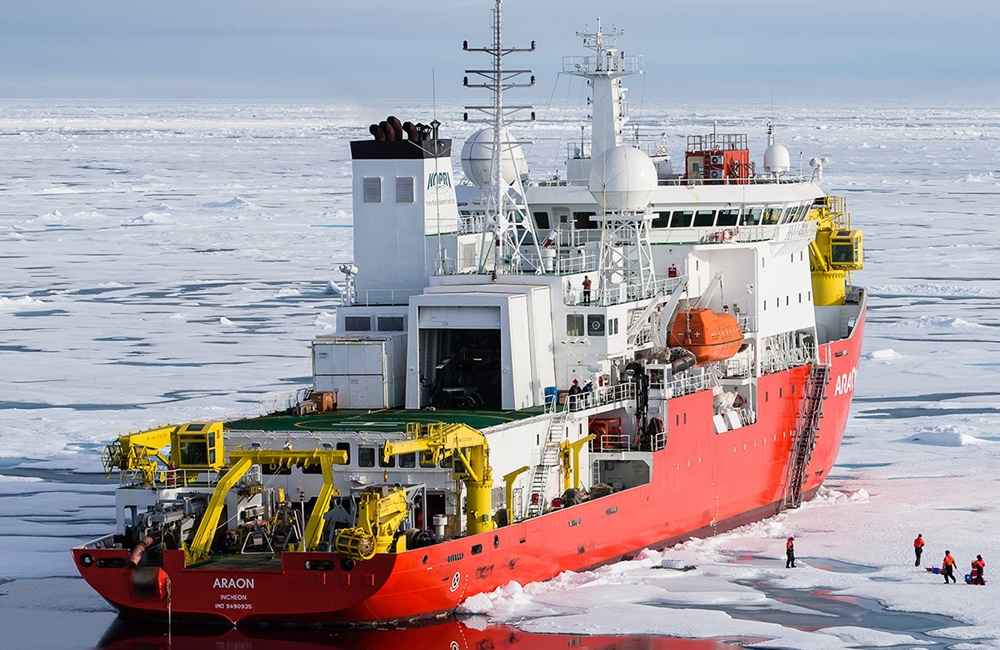Araon icebreaker
Araon icebreaker current position
The current location of Araon icebreaker is in North Pacific Ocean (coordinates 27.11503 N / 141.79012 E) cruising en route to KRKAN. The AIS position was last reported 1 hour ago.
Current PositionSpecifications of Araon icebreaker
| Year of build | 2009 / Age: 16 |
| Flag state | Korea |
| Builder | Hanjin Heavy Industries/Yeongdo Shipyard (Busan, Korea) |
| Class | PC10 icebreaking research vessel |
| Ferry route / homeports | Incheon |
| Building cost | KRW 108 billion (USD 94 million / EUR 65,5 million) |
| Engines (power) | Wartsila ( MW / 0 hp) |
| Propulsion power | 10 MW / 13410 hp |
| Speed | 16 kn / 30 km/h / 18 mph |
| Length (LOA) | 111 m / 364 ft |
| Beam (width) | 19 m / 62 ft |
| Gross Tonnage | 6950 gt |
| Passengers | 60 |
| Crew | 25 |
| Decks | 6 |
| Decks with cabins | 3 |
| Owner | Ministry of Land, Infrastructure and Transport (South Korea) |
| Operator | Korea Polar Research Institute (KOPRI) |
Araon icebreaker Review
Review of Araon icebreaker
The 2009-built RV Araon is an icebreaking research vessel (RV) and South Korea's only icebreaker. The ship was constructed by Hanjin Heavy Industries, at the Yeongdo Shipyard in Busan.
The vessel (IMO number 9490935) is Korea-flagged (MMSI 441619000) and registered/homeported in Incheon.
The name "Araon" combines two Korean words - "ara" (sea) and "on" (all).
History - construction and ownership
The shipbuilder (Hanjin Heavy Industry Co Ltd) is a 1937-founded shipbuilding company headquartered in Busan. The company specializes in gas platforms and gas carriers (LNG and LPG) and the construction of various types of marine vessels, including cable-layers (cable-laying ships), container ships, icebreakers, hovercrafts, naval vessels (warships, patrol boats). Hanjin Heavy Industry is a subsidiary of the Seoul-based Hanjin Group (one of South Korea's largest corporations).

South Korea's icebreaker project started in 2003 (when the feasibility study was carried out), followed by completing the design development (2004) and construction documents (2005). The ship's construction started in May 2006. The launch/float out from drydock was on June 11, 2009, the delivery was in September. The commissioning (by MOLIT/South Korea's Ministry of Land, Infrastructure and Transport) was in November 2009.
RV Araon's Maiden Voyage started on December 18, 2009 (from homeport Incheon) and included an anchorage stop/for bunkering in New Zealand (Port Lyttelton/Christchurch on January 8, 2010) and arrival in Antarctica on January 12th. The 10-day sea trials in ice conditions (in Ross Sea) were successfully conducted in January 2010. The location for Korea's second Antarctic base (Jang Bogo) was selected by Araon during the inaugural sailing.
The Araon icebreaker is operated by Korea Polar Research Institute (KOPRI) and is generally used for polar research and logistics/to transport supplies to South Korea's two Antarctic bases - King Sejong Station (1988-established, at King George Island's Barton Peninsula) and Jang Bogo Station (2014-opened, at Terra Nova Bay, Antarctic Peninsula).
- King Sejong Station consists of 11x buildings and 2x observatories, and has capacity to accommodate max 90 people (scientists during summer season). During winter, the base is maintained by 17 people (engineers and scientists). King Sejong Station is usually supplied by the Korean ship RV Onnuri (1991-built, IMO 9011583) and also by aircraft from two Antarctic stations on King George Island - Argentina's Carlini Base (at Potter Cove) and Chile's Eduardo Frei Montalva Base (at Fildes Peninsula).
- Jang Bogo Station is on mainland Antarctica and was inaugurated in February 2014. The base consists of two buildings - one large (sized 4000 m2 / 43055 ft2, star-shaped with 3x wings) plus one smaller (rectangular, warehouse), and has capacity to accommodate max 60 people. During the winter months, the base is maintained by 15 people. In close proximity to Jang Bogo (approx 9 km / 5,5 mi to the south-southwest) is Italy's Zucchelli Station (at Tethys Bay). Jang Bogo Station was built with materials shipped from Busan to Lyttelton NZ, from where they were transported to Antarctica by RV Araon.
RV Araon vessel details and technology
The ship is powered by 2x Wartsila marine diesel engines (5 MW each, total power output 10 MW). The propulsion system is diesel-electric (diesel engine-generated electricity is used to power the propulsion motors). A total of four Wartsila thrusters facilitate the navigation - 2x aft (360-degree azimuthing propellers/out-hull mounted) and 2x bow/tunnel (in-hull mounted). The aft thrusters are also part of the self-healing computing system that allows the vessel to free itself (by shaking to portside and starboard) if it gets stuck in the middle of an ice sheet. The hull's sharper sloping bow/front and the ice knife underneath facilitate the icebreaking process as the ship rises above and break the ice sheet using its own weight.
The icebreaker can navigate with max speed 16 knots (30 kph / 18 mph in open sea/clear waters), service speed 12 knots (22 kph / 14 mph) and icebreaking speed 3 knots (6 kph / 3,5 mph) in max ice thickness 1 m (3 ft). The hull is constructed by using steel plates with thickness 4 cm (1,6 inches).
Storage facilities' and fuel tanks' capacity allows autonomous navigation/range 20000 nm (37000 km / 23000 mi) and endurance 70 days. The ship can operate in the air temperature range -30C (-58F) to +50C (122F). The design allows safe navigation in "Sea State 6" conditions ("very rough", with wave heights 4-6 m / 13-20 ft) and survival in "Sea State 8" conditions ("very high, with wave heights 9-14 m / 30-46 ft).
Onboard are carried one cargo barge (length 10 m / 33 ft), one workboat (length 7 m / 23 ft), 2x lifeboats (portside and starboard), a mini-submarine, one aircraft (a helicopter parked on the Helideck or in the adjacent Hangar). The aft-positioned helipad is adjacent to the Working Deck (served by a heavy crane).

The ship has storage space/cargo capacity for a total of 46x TEU-containers, including 31x stored on the open-air Work Deck and 15x in the Cargo Hold. Araon's max passenger capacity is 60 (mission personnel and scientists) in addition to the 25 crew (Captain, officers, permanent staff). Most cabins are with double-occupancy and all are fitted with bunk beds, LCD TVs, en suite bathrooms (WC-toilet, washbasin, shower), and mini-refrigerators. Of all the 6 decks, 3 are with staterooms.
The onboard scientific equipment includes a total of 10x research laboratories and network facilities (wet and dry labs, chemical lab, biology lab, Computer Room, LAN Office, data-processing rooms, measurement rooms), CDT/Sonde (oceanographic water sampler that measures seawater's conductivity, temperature, pressure), thermosalinograph (measures in-motion the sea surface's temperature and conductivity), acoustic instruments (multibeam echo-sounders, ADCP/acoustic doppler current profilers, synchronizer), geophysical instruments (multichannel seismic system, dynamic gravity system, SBP/sub-bottom profiler, Thermo PDR/aerosol monitor), biological research instruments (RMT/random matrix theory, Bongo/Plankton Net System, underwater 3D Sensor, MOCNESS synchronous sampling equipment/for zooplankton and sea creatures), observation and monitoring equipment (Weather Station, Radio- and Satellite Antennas, Seawater Analyzer).

